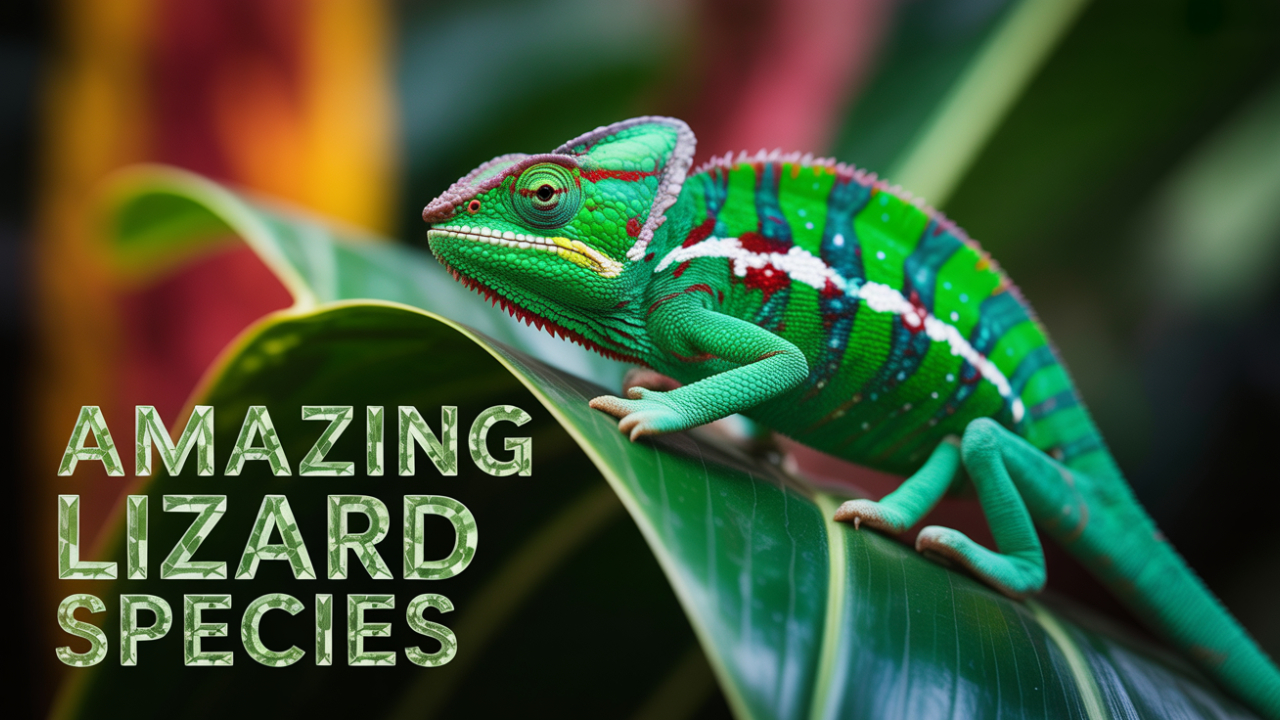All sorts of lizards are a varied and fascinating family of reptiles. As with anything with over 6,000 species, they live everywhere, from desert to rainforest. Their different sizes, colors, and behaviors make them fascinating creatures to study. Some lizards, like the chameleon, are experts at camouflage, while others, such as the iguana, are impressive because of their large size. Knowing these distinctions can help us better appreciate their place in nature. This blog post will explore the various types of lizards, their unique traits, and their significance in the ecosystem.
Understanding Lizard Classification

Lizard classification is a detailed and intricate process that helps us understand the vast diversity among these reptiles. The family and species have their own unique characteristics that help identify and classify each of them.
The Family Tree
The primary lizard families are Iguanidae, Agamidae, Scincidae, and Gekkonidae. Iguanidae includes many robust-bodied, herbivorous lizards. Scincidae presents smooth, shiny scales and a more ground-based existence.
These families have common characteristics, such as limb structure and diet, which emphasize their evolutionary history. The close relationship among these families represents a passage across time, demonstrating how they evolved to inhabit different niches. It is important to know that they belong to different families because in herpetology, that can help researchers learn about their ecological roles and evolutionary adaptations.
Key Infraorders
The main infraorders of lizards are Lacertilia. Physical attributes differ. Members of the Lacertilia infraorder might have long bodies and be nimble, while others are more lethargic.
- Lacertilia: Known for their speed and agility, species like the green iguana fall into this group.
- Gekkota: This group includes geckos, which are notable for their adhesive toe pads.
- Scincomorpha: The skinks, with their smooth scales and burrowing tendencies, belong here.
- Pleurodonta: Anoles are part of this infraorder and showcase impressive color changes.
Defining Traits
Lizards differ from other reptiles by having movable eyelids and external ear openings. Behavioral characteristics, such as sunbathing to maintain body temperature, are shared among species.
These characteristics boost their survival across environments, from deserts to rainforests. With adaptations ranging from camouflage to specialized locomotion, lizards flourish in varied habitats. The evolution of lizards demonstrates how these adaptations proved essential.
What Are The Different Types of Lizards?

Around 7,000 types of lizards exist worldwide, representing approximately 63% of all known squamates. They range in size from tiny geckos and chameleons spanning only a few centimeters to remarkable monitor lizards, such as the Komodo dragon, which can reach lengths of up to 3 meters. Here, we explore various types of lizards, categorized by their ecological roles and habitats, providing you with a glimpse into their distinct traits.
1. Iguanas
Iguanas flourish in tropical and subtropical habitats, particularly those with lush vegetation. They are largely herbivorous, consuming leaves, flowers, and fruit. Other iguana species, including the green iguana, are social animals, frequently observed basking side by side in trees or asserting dominance through territorial displays. This species is threatened by habitat loss and the pet trade.
2. Geckos
Geckos are incredibly adapted, such as their signature toe pads that enable them to scale smooth walls. They populate ecosystems ranging from tropical jungles to dry deserts. Geckos communicate, sometimes literally talking and chirping to each other. Some of the most popular pet geckos are the leopard gecko and the crested gecko, known for their striking colors and simple maintenance.
3. Skinks
Shining out among them are the skinks, with their smooth, shiny scales. They inhabit various environments, such as forests and grasslands. They are opportunistic feeders and feed predominantly on insects and some plants. Conservation is a concern for some skinks, as habitat loss imperils them.
4. Monitor Lizards
Monitor lizards range in size, with some species measuring over 2 meters long. Their tails are long, and their bodies are sturdy, helping them be the top predators they are. These carnivorous lizards use anything from ambushing to active foraging to catch their prey. Significantly, the Komodo dragon is endangered due to habitat loss and climate change.
5. Chameleons
Chameleons are known for their color shifting, which they use to communicate and apply camouflage. They’re arboreal with specialized climbing feet. Most chameleons, in fact, are in Madagascar, which boasts a wealth of species. Tragically, habitat loss threatens them.
6. Legless Lizards
Legless lizards look like snakes because of their long bodies and absence of limbs. They are usually found in sand or loose soil, which they burrow in. Their diet mainly consists of small invertebrates, making them fierce hunters. Their loss of limbs has enabled them to worm their way through thick ground cover.
Beyond the Big Six
Though the commonly-known lizards such as iguanas and chameleons dominate the conversation, several lesser-known species make up the incredible diversity of lizards. Such species frequently have specialized adaptations for particular habitats, highlighting the diversity of the lizard family.
Beaded Lizards
Beaded lizards are unique because of their bead-like scales. These scales act both defensively and as camouflage in their barren environments. Beaded lizards are venomous and use their toxin to immobilize prey such as small mammals and birds. Unlike most lizards, they’re slow, deliberate hunters and frequently ambush their prey.
Usually inhabiting arid areas of Mexico and the southwestern US, beaded lizards gravitate to rocky lands and sparse flora. They are threatened by habitat loss and illegal trade as pets. Now they’re Near Threatened.
- Beaded lizards can grow up to 76 centimeters (30 inches) in length.
- Their venom isn’t deadly, but it is extremely painful.
- They’re one of the only venomous lizards on the planet.
Alligator Lizards
Alligator lizards sport their own unique armored look, featuring tough, scaly skin similar to an alligator. This armor offers defense to predators while in their rocky, wooded environment. They feed mainly on insects and small mammals and lizards.
Native to North America, particularly California, these lizards live in areas with abundant cover, including leaf litter and underbrush. Others encounter conservation issues from habitat loss and climate change.
- Alligator lizards can reach lengths of up to 64 cm (25 inches).
- They are characterized by their robust, athletic bodies that facilitate climbing.
- Many alligator lizard species exhibit a vibrant coloration.
Night Lizards
Night lizards are well adapted to a nocturnal existence, having exceptional eyesight in dim light. They have a special reproductive strategy as they are live-bearing, which is not common in lizards.
Commonly inhabiting rocky outcrops and desert areas of the Americas, night lizards survive in places where they can conceal themselves from predators. Some species are vulnerable to habitat degradation and climate change.
- Night lizards are tiny, typically about 15 to 20 centimeters in length, which is 6 to 8 inches.
- They are primarily insectivorous, feeding on various insects.
- Their camouflage among stones helps these little guys survive.
Lizard Survival Strategies
Lizards have developed a variety of survival strategies that enable them to thrive in diverse environments while avoiding predators. These survival strategies are vital to their existence and emphasize how fascinatingly they engage with their environment.
Camouflage
Lizards use camouflage to merge with their surroundings, preventing predators from noticing them. This capacity to imitate colors and patterns of their environment gives them an armor of protection. For example, the green anole can change his shade to blend in with leaves or the horned lizard camouflages himself against the desert sand.
Camouflage is not just about eluding the eye. It’s not just about lizard survival. If a lizard is colored, it can ambush prey or escape capture. Evolutionarily, it makes sense because if your lizard blends in better, it’s more likely to survive and have babies.
- Notable camouflage strategies include: * Green anole’s color-changing power
- Horned lizard’s armor
- Leaf-tailed gecko’s leaf-like shape
Autotomy
Autotomy is when lizards voluntarily drop their tails as a distraction for predators. This means that the tail has a physiological response that loosens its grip at certain fracture planes, so the lizard can make a speedy exit.
When a lizard loses its tail, it can regrow it. This regeneration can bring trade-offs, like slower movement and energetic expenses in regrowing the tail. Animals such as the common skink and green iguana are excellent examples of this strategy.
Though autotomy may spare a lizard’s life, the lizard might lose its ability to balance or store fat reserves. This creates a conundrum between short-term survival and long-term fitness.
Diet
Lizards have a diverse range of eating habits, with some, such as the green iguana, being herbivores, while others, like the Komodo dragon, are carnivores. This variety in diet affects their habits and habitats, with lizards seeking out areas that offer their particular food.
| Lizard Species | Diet Type | Key Food Sources |
|---|---|---|
| Green Iguana | Herbivorous | Leaves, fruits |
| Komodo Dragon | Carnivorous | Small mammals, carrion |
| Blue-Tongued Skink | Omnivorous | Insects, fruits |
Lizards’ diets influence not just their physiology but their ecological roles. By eating a variety of foods, they provide their ecosystems with pest control and seed dispersal.
A World Without Lizards
Lizards are crucial for a healthy ecosystem. They have a very important impact on biodiversity and ecological balance. Their absence would send a ripple effect through several habitats, affecting thousands of organisms and processes.
Ecological Impact
Lizards are both predators and prey, filling an important niche in food webs. They feed on insects and other small invertebrates, which aids in controlling those populations. In turn, they’re food for birds, mammals, and larger reptiles, continuing the circle of species within their ecosystems.
Aside from their impact on insects, lizards help with soil and plant diversity. Their tunneling aerates the earth, promoting nutrient exchange and the absorption of water. This promotes plants, which promote habitat and food sources for other animals.
As elements of food webs, lizards increase ecosystem stability. If we allow lizards to slip by the wayside, insect populations could explode, resulting in crop devastation and a ripple effect on other animals who rely on those plants for sustenance. Habitat loss due to urban and agricultural expansion has already begun to rattle lizard ranks and emphasizes their precarious position.
Human Connection
Lizards are culturally significant. For example, in certain cultures, they represent tenacity and flexibility, whereas in others, they appear in myths and artwork.
Lizards are an invaluable tool for scientific research and education. They are a model organism for evolutionary biology and ecology, guiding the scientific community in understanding greater ecological dynamics. Lizards are favored pets, cultivating bonds that build empathy and boost conservation awareness.
It’s not exactly ethical to capture and take care of them. Keeping them healthy in captivity and ensuring their wild habitats are safe has to be a priority.
Conservation Status
These days, lizards are threatened by habitat loss, climate change, and invasive species. The IUCN has a few species on the endangered list as well.
Key organizations dedicated to lizard conservation include:
- IUCN
- The Nature Conservancy
- World Wildlife Fund
- Herpetological Conservation International
- Reptile and Amphibian Conservation
My Favorite Lizard Encounters
I love lizards so much. They’re like my good friends. My encounters with these reptiles have offered unique insights into their behavior and role in ecosystems.
One of the most memorable ones was from hiking in a national park. A brilliant green anole soaked in the sun on a rock, his color changed with the light. It was mesmerizing to see it shift colors and it ignited a fascination with the variety of lizards. These small moments remind us that every creature has a function in its ecosystem, from pest control to pollination.
Lizards make fascinating pets. A lot of people love to raise a leopard gecko or bearded dragon. The connection that forms from daily interaction instills a sense of accountability and reverence for life. Observing their habits, be it how they hunt or bask, brings greater insight into their needs and behavior.
It’s no joke how much you learn from lizards in the wild. Field studies provide important insights into their interspecies interactions and response to climate change. Take the blue-tailed skink, for example, which can demonstrate how reptiles modify their actions in response to environmental challenges. This information can shape conservation and highlights the importance of preserving these environments.
Let this be an encouragement to respect lizards. They’re great signposts for the health of an ecosystem. Where lizards begin to disappear, so do we. By celebrating their place in ecosystems, we can promote conservation and protect habitats. Easy steps such as planting lizard-friendly gardens or aiding local wildlife efforts can help.
Conclusion
There are all kinds of lizards. From the everyday anole to the dazzling chameleon, each variety offers its own special characteristics and habits. Knowing where they fit in nature makes us appreciate them as well. Every lizard, whether large or small, contributes to the intricate ecosystem they inhabit. Their survival skills spark fascination.
Getting turned on to these critters sets new horizons open. From wild encounters to pet companionship, lizards provide insight into nature’s diversity. Taking these facts to heart may just inspire your passion for preservation.
Take some time and watch the lizards around you. Observe their behavior and environment. Each meeting enhances your appreciation for these captivating reptiles.
Frequently Asked Questions
What are the main characteristics of lizards?
Lizards are a type of reptile characterized by scaly skin, four legs, and a long tail. They come in all sizes and colors, and the majority are cold-blooded, meaning they depend on their surroundings to maintain body heat.
How many types of lizards are there?
Claim: All species of lizards break down into different families, each with their own characteristics and environments.
What is the largest species of lizard?
The Komodo dragon is the biggest lizard. It can grow to be three meters long. It hails from a handful of Indonesian islands and is a ferocious hunter.
Can lizards change color?
Okay, some lizards can change colors. This skill aids them in both thermoregulation and camouflage and communication.
What do lizards eat?
About all the kinds of lizards. Certain big varieties will consume fruits, foliage, or even tiny mammals.
How long do lizards live?
It depends on the species. Smaller lizards might only live a couple of years, whereas larger iguanas can live for over 20 years in captivity.
Are lizards dangerous to humans?
Most lizards won’t hurt humans. Some, such as the Gila monster, can be venomous. You gotta respect the lizards and keep your distance.





